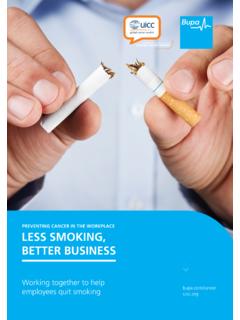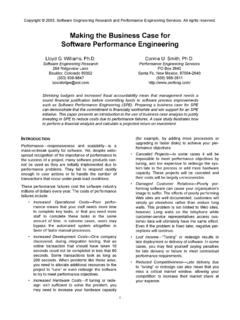Transcription of Healthy workplace, healthy workforce, better …
1 Health and Safety Executive Healthy workplace , Healthy workforce , better business delivery Improving service delivery in universities and colleges through better occupational health Health and Safety Executive The workplace has a significant impact on people's health and well-being. Poor Healthy workplace , Healthy workforce , management of workplace health can lead to work-related ill health and to high better business delivery levels of sickness absence. This gives real cause for concern, not least because of Improving service delivery in universities and colleges through better occupational health the costs involved, the impact on service delivery and the consequences for individual staff. Sickness absence is a key business issue, and it is a key indicator of how well an organisation is managed. Universities and colleges need Healthy and well-motivated workers if they are to deliver high-quality services.
2 Effectively managing occupational health is key to achieving this. None of us doubts the negative effects of smoking, excessive alcohol consumption or obesity on health, but few of us have any understanding of the value of work to an individual's health. Work is important not only to This is a web-friendly physical and mental health, but also for social integration. People are version of leaflet diminished by the experience of long-term sickness absence; loss of contact MISC743 with the world of work means they lose skills and confidence in returning to work.'. Professor Dame Carol Black, National Director for Health and Work I want to see well- managed, Healthy universities and colleges Committing resources to prevent people being made ill by work, or being absent with well-motivated, from the workplace for health reasons, and placing an emphasis on rehabilitation Healthy staff.
3 I know good and getting people back to work can benefit both employers and employees. practice exists, the challenge is to make sure A major survey of sickness absence trends* has demonstrated a clear link between it becomes embedded addressing sickness absence and improved business performance. across the whole of the higher education sector.'. Those companies who still put this issue in the too difficult tray would do Lord Hunt of Kings Heath, well to sit up and take note of the very real benefits they would reap from Minister responsible for tackling the problem.'. health and safety EEF Chief Medical Adviser and Health and Safety Commissioner, Professor Sayeed Khan n To deliver these benefits we must: create workplaces where health, safety and well-being is protected and promoted;. ensure staff have access to competent occupational health advice and support.
4 Improve access to preventative care and treatment for common health problems;. enable people to remain in work while health problems are investigated and * Sickness absence and treated; and rehabilitation survey EEF 2006 support and engage healthcare professionals on return-to-work issues. 1 of 6 pages Health and Safety Executive This is high on the Government's agenda. The Health, Work and Well-being (HWWB) strategy, a joint initiative between the Department of Health, Department for Work and Pensions and the Health and Safety Executive, encourages good management of occupational health and improved opportunities for people to recover from illness while at work. The work of the Ministerial Task Force for Health, Safety and Productivity supports HWWB by making sure that the public sector leads by example. This may seem like a difficult challenge, but the solutions are not rocket science', they are at the heart of what well-managed organisations do.
5 How to do it Occupational health is about how work and the work environment can affect an employee's health and equally how an employee's health can affect their ability to do the job. The Council has seen a 59% reduction in the number of total days lost between 2001 and 2004 as a result of visible and sustained leadership from the Chief Executive Officer, who has proactively and visibly supported initiatives to tackle this issue. Buckinghamshire County Council A very straightforward approach can be taken to effective management of occupational health to help deliver reductions in sickness absence. It needs: Sustained leadership from managers at the top level. Without it, an organisation will not be motivated to take action. Institutions where the vice chancellor makes it clear that managing occupational health, safety and sickness absence is a key priority will be the institutions that really get things done.
6 A good occupational health service. Investing in improved and more proactive occupational health arrangements can deliver efficiency savings in a relatively short timescale. A proactive occupational health service and a Healthy and supportive working environment play an important part in preventing both work- related ill health and in proactively managing common health problems in order to help employees remain in work. Training and support for line managers, because their relationships with their teams are what can make a real difference. Regular, supportive contact with those who are absent due to sickness. This can have a major impact on an individual's motivation to get back to work. The right systems and data to support better absence management. To effectively manage occupational health and safety, and reduce the time lost to sickness absence, institutions will need to have systems for recording up-to- date and accurate sickness absence data that operate in real time, and allow sickness to be broken down by area and cause on a regular basis.
7 This real-time reporting enables you to proactively target specific action to problem areas, and is the best way to measure progress towards tackling sickness absence. This approach is bearing fruit. The CBI/AXA** survey on sickness absence shows an overall fall in absence levels in the public sector'. The evidence suggests that ** Absence minded: Absence and the measures being implemented are responsible for helping to drive down labour turnover CBI/AXA 2006 absence rates. But there is more to do. Healthy workplace , Healthy workforce , better business delivery 2 of 6 pages Health and Safety Executive The hospital has successfully tackled sickness absence caused by musculoskeletal problems. Investing in an initiative to fast-track employees to physiotherapy services has resulted in a reduction of 1674 days lost in the first year. A 300% return on investment has been achieved by this initiative.
8 West Sussex Hospital Prevention is better than cure Tackling sickness absence itself is only one side of the coin. It is far better if the problem is prevented from occurring in the first place. This is the philosophy behind the work of the Ministerial Task Force. Work-related ill health accounts for some 28 million working days lost a year in Great Britain. By far the biggest cause of this up to half of all work-related absence in the education sector is stress and related mental health issues. Stress has to be tackled if significant improvements in attendance and productivity are to be made. HSE's Stress Management Standards are part of a tried and tested methodology that can be applied to work-related stress in the higher education sector. The standards are designed to help organisations look at the underlying causes of workplace stress, focus on the hotspots' where it is most prevalent, and tackle it.
9 They are recommended by the University and Colleges Employers' Association (UCEA) guidance Preventing and tackling stress at work as the safest and simplest way of managing work-related stress. Through these standards, new cases of work-related stress can be prevented and the problem of sickness absence reduced. Not only will tackling stress improve the health and well-being of your most valuable asset, your people, it will also deliver efficiencies as a result. The Stress Management Standards are available online at: The indicator tool at the heart of HSE's Management Standards approach is simple to understand and relatively easy to use. Have a look at the help and advice on work-related stress that HSE has to offer it's free!'. Sheffield College Once we agreed that the Management Standards process must be incorporated into everyday work, it worked very well.
10 We have already seen an increase in staff motivation and can see the potential for long-term rewards.'. Coleg Glan Hafren The questionnaire ties in well with good management practices. The process has worked well and has improved trust with staff and the unions. It has been a very positive experience for all involved.'. De Montfort University Healthy workplace , Healthy workforce , better business delivery 3 of 6 pages Health and Safety Executive Occupational health services Good occupational health services are central to the effective management of workplace health. They can: protect and promote the health and well-being of the working population, creating a healthier workplace and a healthier workforce which will also protect and enhance your image and reputation as a good employer;. provide early intervention to help prevent staff being absent for health-related reasons, and improved opportunities for people to recover from illness while at work.
















